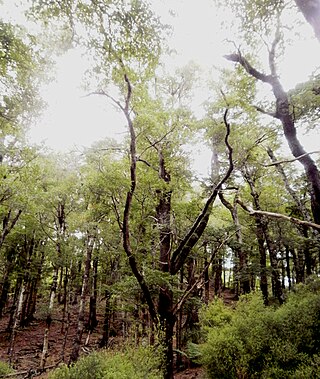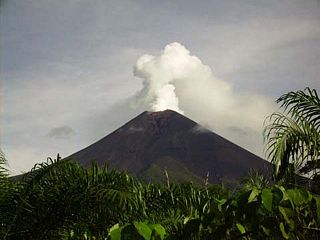
Nothofagus, also known as the southern beeches, is a genus of 43 species of trees and shrubs native to the Southern Hemisphere in southern South America and east and southeast Australia, New Zealand, New Guinea, and New Caledonia. The species are ecological dominants in many temperate forests in these regions. Some species are reportedly naturalised in Germany and Great Britain. The genus has a rich fossil record of leaves, cupules, and pollen, with fossils extending into the late Cretaceous period and occurring in Australia, New Zealand, Antarctica, and South America.

Nothofagus truncata, or hard beech, is a species of tree endemic to New Zealand. Its common name derives from the fact that the timber has a high silica content, making it tough and difficult to saw. Hard beech is a tree up to 30m tall occurring in lowland and lower montane forest from latitude 35°S to 42°30'S, that is, from the north of the North Island southwards to Marlborough and south Westland in the South Island. In Taranaki it forms almost pure stands on the rugged sandstone country there and is partially deciduous, dropping many of its leaves at the end of the winter. N. truncata became known as Fuscospora truncata after 2013 in New Zealand.

Phyllocladus hypophyllus is a species of conifer in the family Podocarpaceae. It a tree native to Borneo, Sulawesi and the Maluku Islands (Indonesia), the Philippines, and New Guinea.
Podocarpus brassii is a species of conifer in the family Podocarpaceae. It is endemic to the island of New Guinea, which is divided between Indonesia and Papua New Guinea.

The New Guinea Highlands, also known as the Central Range or Central Cordillera, is a long chain of mountain ranges on the island of New Guinea, including the island's tallest peak, Puncak Jaya, Indonesia, 16,024 ft (4,884 m), the highest mountain in Oceania. The range is home to many intermountain river valleys, many of which support thriving agricultural communities. The highlands run generally east-west the length of the island, which is divided politically between Indonesia in the west and Papua New Guinea in the east.
Nothofagus nuda is a species of plant in the family Nothofagaceae. It is endemic to Papua New Guinea. It is threatened by habitat loss.
Nothofagus stylosa is a species of plant in the family Nothofagaceae. It is endemic to West Papua (Indonesia). It is a Critically Endangered species threatened by habitat loss.

The Central Range montane rain forests is a tropical moist forest ecoregion on the island of New Guinea. The ecoregion covers the Central Range of the New Guinea Highlands, which extends along the spine of the island. The montane rain forests of the ecoregion are distinct from the surrounding lowland forests, and are home to many endemic plants and animals.
Heptapleurum polycladum is a plant species endemic to in Papua New Guinea. It is an extant taxon. It is a scrambling tree which grows from 4 to 15 meters tall. It is likely pollinated by insects, and its fruit and seeds dispersed by birds.
Heptapleurum stramineum is a species of flowering plant in the family Araliaceae. It is a scrambling tree endemic to Papua New Guinea.

The New Britain–New Ireland montane rain forests is a tropical moist forest ecoregion in Papua New Guinea. The ecoregion includes the mountain rain forests on the islands of New Britain and New Ireland, which lie northeast of New Guinea.
Nothofagus brassii is a species of tree in the family Nothofagaceae. It is endemic to New Guinea. It is commonly known as Sagé, sagé hitam, sahé, and kayu sagé, kayu sagé hitam (Indonesian).
Nothofagus carrii is a species of tree in the family Nothofagaceae. It is endemic to New Guinea.
Nothofagus crenata is a species of tree in the family Nothofagaceae. It is endemic to New Guinea. It grows in lowland rain forest below 900 meters elevation.
Nothofagus grandis is a species of tree in the family Nothofagaceae. It is endemic to New Guinea. It grows in lower montane rain forests from 900 to 1,500 meters elevation.
Nothofagus perryi is a species of tree in the family Nothofagaceae. It is endemic to Papua New Guinea. It grows in montane rain forests from 1,500 to 2,500 meters elevation in central and southeastern Papua New Guinea.
Nothofagus pseudoresinosa is a species of tree in the family Nothofagaceae. It is endemic to Papua New Guinea. It grows in montane rain forests from 2,500 to 2,750 meters elevation in central and southeastern Papua New Guinea.
Nothofagus pullei is a species of tree in the family Nothofagaceae. It is endemic to New Guinea. It grows in montane rain forests from 2,350 to 3,200 meters elevation.
Nothofagus resinosa is a species of tree in the family Nothofagaceae. It is endemic to New Guinea. It grows in montane rain forests at around 1,560 meters elevation.
Nothofagus rubra is a species of tree in the family Nothofagaceae. It is endemic to New Guinea. It grows in montane rain forests.






